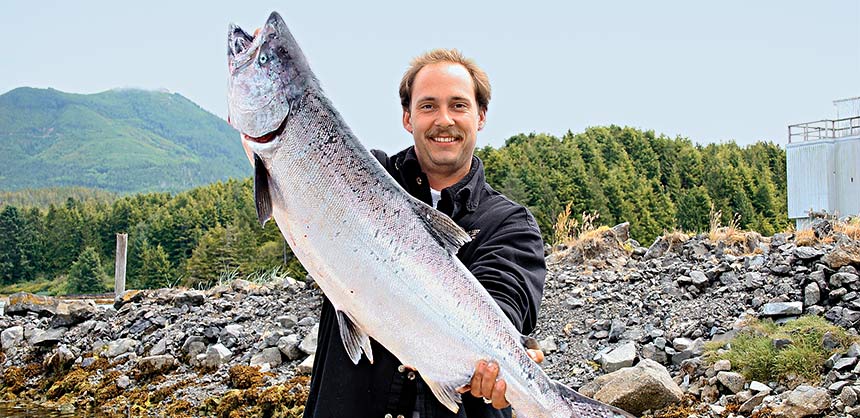Bucket List TravelOctober 1, 2017
Reward Incentives Not Just for Individual Travelers Anymore By Nancy AldermanBucket List Travel
Reward Incentives Not Just for Individual Travelers Anymore
Check it off of your bucket list: Travel incentives today can be used in a variety of ways, such as for participating in a salmon and trout fishing experience in Alaska. Credit: Pulse Experiential Travel
 Nancy Alderman, IP, is Associate Director of TSYS Loyalty, Specialty Travel Division. She has been with the company for more than 20 years and has been instrumental in its growth and the expansion of travel incentive offerings. TSYS Loyalty is the premier rewards provider inspiring loyalty between financial institutions and their customers. In addition, she serves as Board Secretary of the Incentive Travel Council.
Nancy Alderman, IP, is Associate Director of TSYS Loyalty, Specialty Travel Division. She has been with the company for more than 20 years and has been instrumental in its growth and the expansion of travel incentive offerings. TSYS Loyalty is the premier rewards provider inspiring loyalty between financial institutions and their customers. In addition, she serves as Board Secretary of the Incentive Travel Council.
For many years I have watched my specialty travel advisors help customers who had saved reward points for years to fulfill their dreams with once-in-a-lifetime “bucket list” travel adventures. Trips to Machu Picchu, an Incan citadel set high in the Andes Mountains of Peru, or Antarctica, where you can be surrounded by penguins and watch whales and seals, are just two examples.
Over the last few years we have been seeing an emerging trend: more of these trips include several generations of family members or even extended family. Destinations that at one time were strictly targeted for individual incentive travel now are being chosen as spots for small groups, corporate sales incentive programs and even larger corporate events, which are now being held at top bucket list destinations such as Fiji, Iceland, Paris, Lake Louise in Alberta, Canada, and Australia.
Sharing Travel Rewards Creates Better Experiences
Many loyalty rewards participants are cashing in their points and using them for team outings such as a Montana trout fishing experience. The Big Sky state is the hotbed of Western trout fishing in the U.S., thanks to its endless miles of quick-flowing rivers with freestone beds. Other trips may involve playing a round of golf with far-flung family members at famous Five Star golf resorts. Previously, many of these individuals would only use their reward points to take trips by themselves or with friends and immediate family members; now they are sharing these experiences with others.
I took my specialty travel advisors along to fulfill one of my bucket list items. My team thought it was a familiarization trip for them and their families to ClubMed Sandpiper Bay, which turned into a lifelong memory when we took part in a teambuilding exercise at the Flying Trapeze School. At the start of the activity I heard a lot of “I’m not going to do that, are you crazy?” But later I heard shouts of jubilation like “I can’t believe I just did that” as we performed daring aerial performances for our families and friends. Having people with you that are a part of your life as you achieve these bucket list goals makes them so much more rewarding and memorable.
Marc Matthews, president of Pulse Experiential Travel and past president of the Incentive Travel Council (ITC), a strategic travel group that’s part of the Incentive Marketing Association, shared his insights on the growth of bucket list travel experiences. “The strength of the U.S. dollar has made it a lot easier and more affordable for individuals to travel abroad to exotic and unique destinations,” he said. “Experiences and destinations once considered too expensive or geographically challenging to be realistic for the individual traveler have now become viable options.
“The digital/social media age we now live in also allows consumers to be more connected with each other and to share the excitement associated with planning their upcoming experience. The net result of this emotional engagement is more people traveling together sharing that experience,” Matthews explained.
The push toward travel experiences has continued to grow on a number of fronts. The Incentive Research Foundation (IRF) recently released a study, “The Emerging ‘Next Level’ of Experience: Individualized Experiences and the Importance of Emotion,” that demonstrates how “tapping emotional engagement through a strategic choice of rewards and incentives is a powerful way for businesses to motivate their stakeholders. One of the primary ways to tap emotion is through experiences.” The point is that the type of reward that redemption travel offers to today’s loyalty program participant differs from the basic airfare or hotel options of the past.
Travel Incentives Can Encourage Employee Performance
According to the IRF study, 42 percent of travel reward programs are increasing the number of “experiential rewards” in their portfolios (e.g. spa days, concert tickets, expensive dinners, sporting events, etc.). The focus of travel now is not just on the destination and hotel; equally important are authentic, unique, individualized experiences delivered during the trip. This has led to the introduction of mini-experiences into trips, such as various types of tastings, personalized training sessions or behind-the-scenes introductions to chefs.
As new suppliers enter the market and program designers gain comfort and expertise with novel approaches, participants will be treated to a host of innovative and memorable experiences. With at least three generations (baby boomers, Generation X, millennials and soon, Generation Z) being served by incentive programs, it is more important than ever that programs are personalized for participants. As the experiential travel redemption options available to a program participant become more personalized, it seems only natural that they are shared with family and extended family members.
As memorable as these trips may be, Matthews emphasized that it’s not just about jumping on the experience bandwagon; experiential travel can help organizations to grow business performance by offering a chance at rewarding travel experiences. The Incentive Travel Council’s white paper “The Business Case for Incentive Travel” showed “a strong testament to travel as a motivational tool,” citing studies showing that all “Best in Class” companies (meaning those with the highest year-over-year sales increases and highest customer retention) said they use travel to recognize and reward annual sales success. I&FMM








